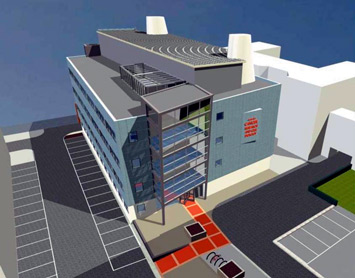| 2005 |

|
YEAR BOOK |
Queen's University Belfast
|
The Centre for Cancer Research and Cell Biology Queen's University Belfast
|

The Centre has been formed as a result of a �15.8 million grant under the second round of the Support Programme for University Research (SPUR), �2.8 million from the Science Research Investment Fund (SRIF) as well as a �1.7 million investment by Queen's University. The SPUR Programme is a public/private partnership financed by the Department of Employment and Learning and The Atlantic Philanthropies. The establishment of the CCRCB has galvanised the development of the strategy that the University outlined in the 1998 Academic Plan to enhance the reputation of Queen's as a University of national and international standing. In the Strategic Plan developed in 2002 the University committed itself to the development of an Institute of Health and Life Sciences (IHLS) in order to achieve greater integration, cost effectiveness and critical mass through interdisciplinary research centres that would focus on a small number of health and life science areas. The development of the CCRCB spearheads the development of the IHLS and acts as an exemplar for the development of its other constituent Centres.
Agreement has been reached with the Belfast City Hospital Trust for the purchase and clearance of the site (adjacent to the Medical Biology Centre and Whitla Medical Building) to make way for the development of the 4500m 2 four-storey building. The design team has been appointed by competitive tender and the University was fortunate to be able to enter into a contract with Boswell Mitchell Johnston (BMJ) architects, a Scottish firm with a lot of experience in building biomedical research facilities in Scotland and the rest of the UK. The building is designed primarily as a generic research facility housing most staff with an interest in bio-molecular research and synthetic chemistry. Construction of the building started in September 2005 and the building is due for completion in April 2007.
|
MISSION STATEMENT |
| The Centre for Cancer Research and Cell Biology provides an integrated infrastructure, with the expertise and technology base to further develop internationally competitive research programmes with goals in Cancer Research and Cell Biology aiming at drug target discovery, validation and clinical implementation. |
The CCRCB aims to develop post-genomic basic research and its clinical application. Our strategy is to create, by collaboration between existing groups and targeted new appointments, a multidisciplinary research facility addressing the co-ordinated biological regulation of cellular function and strategies to perturb biological information transfer . This encapsulates the perspective that normal cells are highly organised and controlled biological systems and that cancer represents loss of these normal regulatory mechanisms in cells. Identification of critical components that are perturbed in cancer opens the door for rational design of novel diagnostic and clinical therapeutic stratagems. Three of the principal programmes within the Centre address cell biological aspects of the Cancer Cell and Molecular Biology, Cell Biology in Infection and Immunity, and Stem Cell Biology. The programme in Medicinal Chemistry focuses on drug design and proteolytic enzyme inhibitors. The fifth programme, Experimental Medicine, has a strong clinical translation and clinical trials focus.
The hallmark of our research programme is a close collaborative interaction between clinical and laboratory experts that ultimately enhances the quality and scope of our basic and clinical research programmes in cancer and in other diseases.
Our goals are:
-
To provide an internationally competitive multidisciplinary research centre of the highest quality;
-
To foster the generation of scientific knowledge and share that knowledge with researchers, clinicians and the public through educational activities, training programmes and publications;
-
To improve patient care through clinical trial research and the translation of our basic programmes into clinical arenas;
-
To educate and train future clinical and scientific leaders in biomedical research;
-
To develop strong collaborative interactions with research organisations, nationally and internationally;
-
To support commercialisation of our research and accelerate the translation of our discovery to clinical implementation and patient.
Contact: Professor Patrick Johnston,
Centre for Cancer Research and Cell Biology,
Queen's University Belfast,
University Floor, Belfast City Hospital,
Lisburn Road, Belfast, BT9 7AB
; Tel: 028 90 263911.